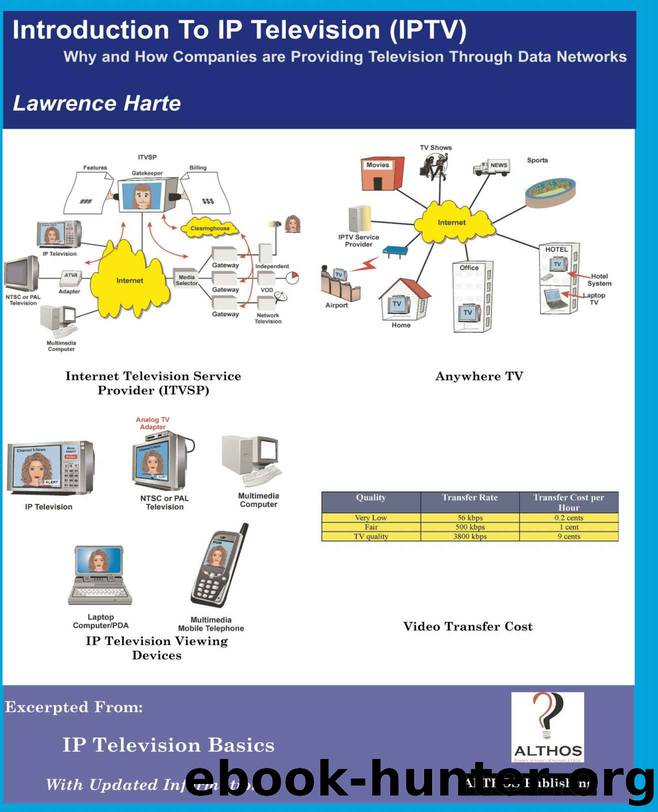Introduction to IP Television: Why and How Companies are Providing Television Through Data Networks by Lawrence Harte

Author:Lawrence Harte [Harte, Lawrence]
Language: eng
Format: azw3
Publisher: UNKNOWN
Published: 2017-03-25T04:00:00+00:00
Broadband Access Systems for IP Television
Broadband access systems are networks that can transfer data signals at a rate of 1 Mbps or more. Broadband access systems that can provide data transmission rates of over 10 Mbps are called Ultra Broadband systems. Broadband access systems that may be suitable for IP television systems include digital subscriber line, cable modems, wireless broadband and powerline data.
Broadband access systems may be controlled (managed) or uncontrolled (unmanaged) systems. Broadband access systems that are controlled can guarantee the performance (data transmission rates). Broadband access systems that are uncontrolled offer best effort delivery.
If the broadband access system has data transmission rates that are several times the required data transmission rates for IP television (2 to 4 Mbps), unmanaged systems may provide acceptable data transmission rates for quality IP television programs.
Digital Subscriber Line (DSL) Digital subscriber lines transmit high-speed digital information, usually on a copper wire pair. Although the transmitted information is in digital form, the transmission medium is an analog carrier signal (or the combination of many analog carrier signals) that is modulated by the digital information signal.
DSL systems have data transmission rates that range from 1 Mbps to over 52 Mpbs. DSL systems have dedicated wire connections between the systems digital subscriber line access modem (DSLAM) and the user’s DSL modem.
The data transmission rates in DSL systems can be different in the downlink and uplink directions (asymmetric) or they can be the same in both directions (symmetric). Because IP television data transmission is primarily from the system to the user (the downlink), asymmetric DSL systems (ADSL) are commonly used.
There are several types of DSL systems including asymmetric digital subscriber line (ADSL), symmetric digital subscriber line (SDSL) and very high bit rate digital subscriber line (VDSL). Of the different types of DSL, some have different versions with varying capabilities such as higher data transmission rates and longer transmission distances.
Because the telephone wires that DSL uses do not transfer high-frequency signals very well (high signal loss at higher frequencies), the maximum distance of DSL transmission is limited. In 2005, the typical maximum distance that DSL systems operated is 3 to 5 miles from the DSLAM. There is also a reduction in data transmission rate as the distance from the DSLAM increases. The further the distance the user is from the DSLAM, the lower the data transmission rate.
The data transmission required for each IP set top box in the home is approximately 2-4 Mbps. As the distance increases from the DSLAM to the customer, the number of set top boxes that can operate decreases. This means that customers who are located close to the DSLAM (may be located at the switching system) can have several set top boxes while IP television customers who are located at longer distances from the DSLAM may only be able to have one IP set top box. As the demand for IP television service increases, the DSL service provider can install DSLAMs at additional locations in their system.
Figure 1.30 shows how the number of
Download
This site does not store any files on its server. We only index and link to content provided by other sites. Please contact the content providers to delete copyright contents if any and email us, we'll remove relevant links or contents immediately.
Sass and Compass in Action by Wynn Netherland Nathan Weizenbaum Chris Eppstein Brandon Mathis(13262)
Implementing Enterprise Observability for Success by Manisha Agrawal and Karun Krishnannair(8231)
Supercharging Productivity with Trello by Brittany Joiner(7479)
Mastering Tableau 2023 - Fourth Edition by Marleen Meier(7230)
Inkscape by Example by István Szép(7121)
Visualize Complex Processes with Microsoft Visio by David J Parker & Šenaj Lelić(6802)
Build Stunning Real-time VFX with Unreal Engine 5 by Hrishikesh Andurlekar(5828)
Design Made Easy with Inkscape by Christopher Rogers(5086)
Customizing Microsoft Teams by Gopi Kondameda(4632)
Business Intelligence Career Master Plan by Eduardo Chavez & Danny Moncada(4587)
Extending Microsoft Power Apps with Power Apps Component Framework by Danish Naglekar(4225)
Salesforce Platform Enterprise Architecture - Fourth Edition by Andrew Fawcett(4111)
Pandas Cookbook by Theodore Petrou(4086)
Linux Device Driver Development Cookbook by Rodolfo Giometti(4047)
The Tableau Workshop by Sumit Gupta Sylvester Pinto Shweta Sankhe-Savale JC Gillet and Kenneth Michael Cherven(3889)
Exploring Microsoft Excel's Hidden Treasures by David Ringstrom(3390)
TCP IP by Todd Lammle(3154)
Applied Predictive Modeling by Max Kuhn & Kjell Johnson(3041)
Drawing Shortcuts: Developing Quick Drawing Skills Using Today's Technology by Leggitt Jim(3037)
